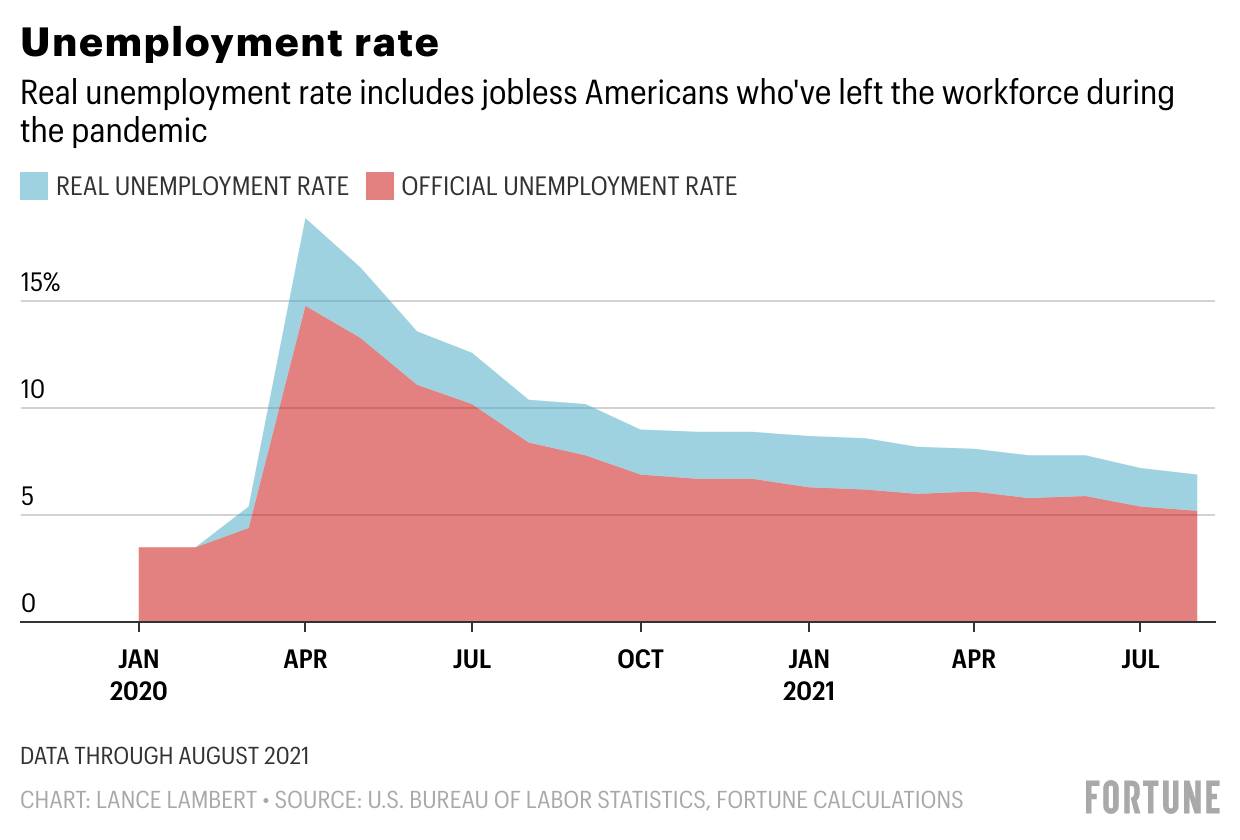毫無疑問,,新冠疫情所引發(fā)的衰退給經(jīng)濟帶來了毀滅性打擊,。在2020年春季的兩個月中,,失業(yè)率從50年以來的最低點3.5%飆升至80年以來的最高點14.8%。本季度,,美國GDP出現(xiàn)了有史以來最大的跌幅,。
不過,這次衰退是來也洶洶,,去也匆匆,。到2020年5月,經(jīng)濟不僅再次恢復增長,,而且增速較快,。2020年第三季度見證了美國歷史上最大的GDP增幅。在大蕭條(Great Recession)時期,,經(jīng)濟增速連續(xù)59個月高于7%的失業(yè)率,。這一次,高于7%的增幅僅維持了6個月的時間,。到8月,,美國失業(yè)率為5.2%,非常接近經(jīng)濟學家所認為的美國“充分就業(yè)”率,。從紙面上看,,此次經(jīng)濟反彈是美國有史以來速度最快的反彈之一。
然而,,快速的恢復并非像人們看到的那樣美好:失業(yè)率其實遠高于紙面上的經(jīng)濟數(shù)據(jù),。
這個數(shù)據(jù)并非偽造或被內(nèi)部篡改,。據(jù)此我們可以得出一個結論:美國勞工統(tǒng)計局(U.S. Bureau of Labor Statistics)的經(jīng)濟數(shù)據(jù)并不完全適用于在新冠疫情期間衡量勞動力市場。
例如,,官方失業(yè)率的計算方法是:美國失業(yè)人數(shù)除以勞動力中的員工數(shù),。然而,如果一名失業(yè)人員并沒有尋找工作,,他們就不屬于任何一個群體,。通常來講,將這類人群排除在外對最終的數(shù)字沒有太大的影響,。然而,,在此次新冠疫情期間的情況卻有所不同,因為有數(shù)百萬員工脫離了勞動力大軍,。
截至8月,,民間勞動力數(shù)量依然比2020年2月低290萬。盡管沒有工作,,但這290萬美國民眾都沒有被計入官方失業(yè)率,。如果計算這些已經(jīng)脫離勞動力大軍的個人,那么“實際”失業(yè)率就將躍升至6.9%,,較官方數(shù)字高出1.7個百分點,。在2020年4月的危機頂峰,“真實”的失業(yè)率達到了18.9%,,高出官方數(shù)字4.1%,。

就像《財富》雜志之前報告的那樣,失業(yè)員工在大蕭條期間脫離勞動力大軍是很常見的事情,,只是如此規(guī)模的脫離在以前從未出現(xiàn)過,。在大蕭條期間,官方失業(yè)率在2009年10月達到了10%的峰值,?!敦敻弧冯s志的計算顯示,如果計算退出勞動力大軍的無業(yè)員工,,那么真實失業(yè)率就將飆升至10.6%。不過,,這個0.6%的差距與我們在這場危機中所看到的規(guī)模相比亦是相形見絀,。
為什么如此多的失業(yè)員工在新冠疫情危機期間不去找工作?
原因有很多,。一些是因為年紀較大或存在感染風險,,他們要等到新冠疫情結束之后才會重新開始找工作,。有的人則是身為上班一族的父母,通常是母親,,他們有的找不到日托服務,,有的則需要居家照看孩子遠程學習。
在2020年2月至4月期間,,美國有近800萬名員工脫離了民間勞動力大軍,。自那之后,勞動力又增長了500多萬,,包括8月新增的19萬,。如果美國維持當前的增速,那么也要到2023年年初才能夠回到新冠疫情前的水平,。簡單來說,,勞動力局面正在改善,但在完全恢復之前仍然有很長的路要走,。(財富中文網(wǎng))
譯者:馮豐
審校:夏林
毫無疑問,,新冠疫情所引發(fā)的衰退給經(jīng)濟帶來了毀滅性打擊。在2020年春季的兩個月中,,失業(yè)率從50年以來的最低點3.5%飆升至80年以來的最高點14.8%,。本季度,美國GDP出現(xiàn)了有史以來最大的跌幅,。
不過,,這次衰退是來也洶洶,去也匆匆,。到2020年5月,,經(jīng)濟不僅再次恢復增長,而且增速較快,。2020年第三季度見證了美國歷史上最大的GDP增幅,。在大蕭條(Great Recession)時期,經(jīng)濟增速連續(xù)59個月高于7%的失業(yè)率,。這一次,,高于7%的增幅僅維持了6個月的時間。到8月,,美國失業(yè)率為5.2%,,非常接近經(jīng)濟學家所認為的美國“充分就業(yè)”率。從紙面上看,,此次經(jīng)濟反彈是美國有史以來速度最快的反彈之一,。
然而,快速的恢復并非像人們看到的那樣美好:失業(yè)率其實遠高于紙面上的經(jīng)濟數(shù)據(jù),。
這個數(shù)據(jù)并非偽造或被內(nèi)部篡改,。據(jù)此我們可以得出一個結論:美國勞工統(tǒng)計局(U.S. Bureau of Labor Statistics)的經(jīng)濟數(shù)據(jù)并不完全適用于在新冠疫情期間衡量勞動力市場,。
例如,官方失業(yè)率的計算方法是:美國失業(yè)人數(shù)除以勞動力中的員工數(shù),。然而,,如果一名失業(yè)人員并沒有尋找工作,他們就不屬于任何一個群體,。通常來講,,將這類人群排除在外對最終的數(shù)字沒有太大的影響。然而,,在此次新冠疫情期間的情況卻有所不同,,因為有數(shù)百萬員工脫離了勞動力大軍。
截至8月,,民間勞動力數(shù)量依然比2020年2月低290萬,。盡管沒有工作,但這290萬美國民眾都沒有被計入官方失業(yè)率,。如果計算這些已經(jīng)脫離勞動力大軍的個人,,那么“實際”失業(yè)率就將躍升至6.9%,較官方數(shù)字高出1.7個百分點,。在2020年4月的危機頂峰,,“真實”的失業(yè)率達到了18.9%,高出官方數(shù)字4.1%,。
就像《財富》雜志之前報告的那樣,,失業(yè)員工在大蕭條期間脫離勞動力大軍是很常見的事情,只是如此規(guī)模的脫離在以前從未出現(xiàn)過,。在大蕭條期間,,官方失業(yè)率在2009年10月達到了10%的峰值?!敦敻弧冯s志的計算顯示,,如果計算退出勞動力大軍的無業(yè)員工,那么真實失業(yè)率就將飆升至10.6%,。不過,,這個0.6%的差距與我們在這場危機中所看到的規(guī)模相比亦是相形見絀。
為什么如此多的失業(yè)員工在新冠疫情危機期間不去找工作,?
原因有很多,。一些是因為年紀較大或存在感染風險,他們要等到新冠疫情結束之后才會重新開始找工作,。有的人則是身為上班一族的父母,,通常是母親,他們有的找不到日托服務,,有的則需要居家照看孩子遠程學習,。
在2020年2月至4月期間,美國有近800萬名員工脫離了民間勞動力大軍,。自那之后,,勞動力又增長了500多萬,包括8月新增的19萬,。如果美國維持當前的增速,,那么也要到2023年年初才能夠回到新冠疫情前的水平。簡單來說,,勞動力局面正在改善,,但在完全恢復之前仍然有很長的路要走。(財富中文網(wǎng))
譯者:馮豐
審校:夏林
The onset of the COVID-19 recession absolutely crushed the economy. In a matter of two months in spring 2020, the unemployment rate shot up from a 50-year low (3.5%) to an 80-year high (14.8%). That quarter, U.S. GDP posted its largest ever contraction.
The recession—while fierce—was also brief. By May 2020, the economy was not only growing again, it was growing fast. The third quarter of 2020 generated the largest GDP uptick in U.S. history. During the Great Recession era, the economy was above a 7% jobless rate for 59 consecutive months. This time, it was above 7% for just six months. As of August, we’re at a 5.2% unemployment rate—pretty darn close to what economists consider the nation’s “full employment” rate. On paper, this rebound is one of the fastest on record.
But this speedy recovery isn’t all that it seems: Joblessness is much higher than economic data would suggest.
The data isn’t cooked or intentionally skewed. Instead, it boils down to the fact that the U.S. Bureau of Labor Statistics’ economic data isn’t well-suited to measure a labor market during a pandemic.
See, the official unemployment rate is calculated by dividing the number of unemployed Americans by the number of workers in the labor force. But if a jobless individual isn’t looking for work, they aren’t included in either grouping. Normally, that exclusion doesn’t have a huge impact on the final figure. But it has in this pandemic, during which millions of workers have dropped out of the labor force.
As of August, the civilian labor force count is still 2.9 million lower than it was in February 2020. Despite not having jobs, none of those 2.9 million Americans are included in the official jobless rate. When including those individuals who’ve dropped out of the labor force, the “real” jobless rate jumps to 6.9%. That’s 1.7 percentage points higher than the official rate. At the height of the crisis in April 2020, that “real” jobless rate was 18.9%—or 4.1 percentage points above the official rate at the time.
As Fortune has previously reported, it’s common for unemployed workers to leave the workforce during deep recessions. Still, nothing on the level we’ve seen this go-around has happened before. During the Great Recession era, the official unemployment rate peaked at 10% in October 2009. If you include jobless workers who had dropped out of the labor force, the real unemployment rate for that rate jumps to 10.6%, according to Fortune’s calculations. But that 0.6% difference pales in comparison to what we’ve seen during this crisis.
Why are so many jobless folks not looking for work during the COVID-19 crisis?
There are a number of reasons. Some are older or at-risk Americans who are waiting for the pandemic to end before restarting their job search. Others are working parents—usually mothers—who’ve either struggled to find day care or needed to stay home while their kids learned remotely.
Between February and April of 2020, the U.S. civilian labor force shrank by nearly 8 million workers. Since then, it’s up by more than 5 million—including another 190,000 uptick in August. If the nation sustains its current pace, it would take until early 2023 just to get back to pre-pandemic levels. Simply put: The labor force situation is improving—but we still have a long road ahead to a full recovery.






